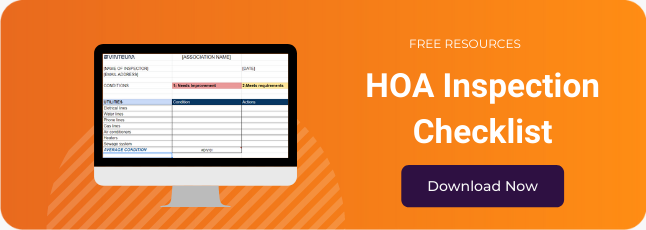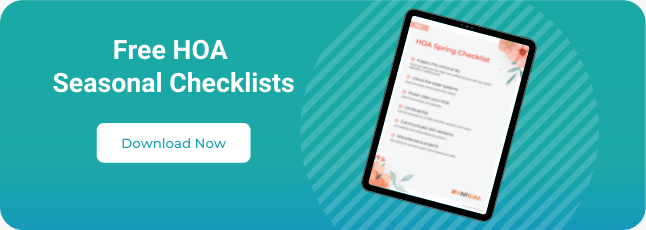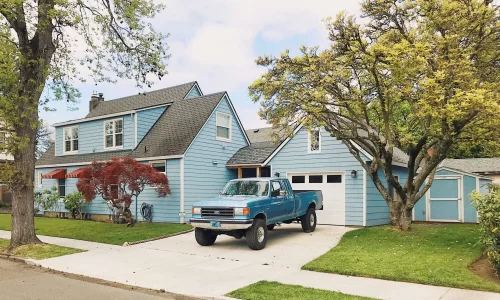Pest infestations can occur in HOAs and Condos, whether you live in the city or in a more rural area. In this article, we’re going to explore how to prevent pest infestations, and when you have one, what is the association responsible for and what is the residents’ responsibility. Then we’ll look at different types of pests and what you can do for each of them.
How to prevent pest infestations in your HOA
When you have a pest infestation it is difficult to get rid of. So, you should put effort into preventing them. To do that you can have regular inspections, landscaping and maintenance. The other important tool to prevent infestations is communication with residents.
Regular HOA Inspections
Having regular HOA inspections will help to identify cracks in the walls that pests may find their way into. This is important to do in common areas. Residents are responsible for doing inspections in their properties. If you have a community association manager, you can ask them to organize regular inspections. Otherwise, the board can reach out to professionals in the area. You can also use an HOA inspection checklist to make a list of everything that needs to be inspected.
Landscaping
By having good landscaping, you can plant plants that pests don’t like to try and keep them away. It will also help you to identify infestations more quickly if they do occur. Spring is a great season to focus on improving your landscaping to prevent pests, but every season is a good time for you to work on different aspects of HOA pest infestations.
Maintenance
It’s important to maintain buildings so that holes don’t appear that pests could use as their home. Another thing that attracts pests is trash, so ensure that it is well disposed of by residents. If the community has communal trash cans, check that they are secure. It’s also important to do water maintenance in your HOA. So if you have a pool or lake, so ensure that the water is clean and not stagnant insects don’t reproduce there.
Communication
By having open channels of communication between residents, the board and manager, you ensure that people know what to do around pests. The board can let residents know what they’re doing, and what they expect residents to do. Also, if a resident notices pests, they know how to tell the board so that it doesn’t get out of control.
You can use social media, texts, calls and emails as communication tools to speak to residents, and so they can talk to you as well.
Who is responsible for pest infestations?
Unfortunately, pests don’t respect the boundaries between common spaces, and residents’ property, so it’s important to work together.
Who pays when there is a pest infestation?
Unfortunately, there isn’t a straightforward answer. You would need to check your state laws and the HOA’s governing documents.
Normally, HOAs are responsible for maintenance and fixing issues in the common areas. These include amenities, lobbies, hallways, sidewalks.
Sometimes associations include in their documents that whoever caused the pest infestation pays to sort out the issue. However, often it isn’t clear as pests can just appear without a clear source. If it isn’t clear, then the board must have clear documentation that shows that they got in touch with the resident and told them the necessary steps.
Can residents deny HOA pest control entry?
Some residents refuse entry, however, there are steps the HOA can take to gain access to the home or unit. You would have to check state law to see what you can do to fix the problem. Again, having documentation proving that you provided notice is important.
Common HOA pests
Rodents
Rodents are a large category, they include rats, mice, rabbits, and gophers.
Rats
Rats are common in large cities and do appear from time to time even if you have the cleanest condo. Residents have a duty to tell the board if rats or mice appear in their unit or home, as there is a huge chance that they are also on common property.
Rabbits & Gophers
With rabbits and gophers, you have to be careful how you go about removing them from the community just in case someone complains, or a child is traumatized by seeing a rabbit in a trap. You can trap and release them, but local laws are different about where you can release them. The rules might also depend on the breed of animal.
Birds
With birds, the easiest method is prevention by installing bird control spikes. This stops them from roosting on the roofs and causing a mess. These are humane, and deter birds, such as pigeons, gulls, and crows, from roosting.
Professional Advice
If you have pigeons that won’t leave, then it’s best to seek professional advice. You’ll also need professional assistance if you have ducks or other waterfowls that have taken up residence by a community pond or lake. Some species are protected, but any professional will be able to advise you.
Bird Feeders
Some communities restrict bird feeders because they create a mess and attract pests, such as squirrels or pigeons. This is a good idea but tread carefully so that residents don’t get too annoyed at the board. Maybe you could allow feeders that are only for small birds.
Insects
To deter some insects, including flies and mosquitoes from buzzing into HOA buildings, you can plant basil, lavender or mint by windows or entrances.
Mosquitos
Mosquitos breed in stagnant water, this could be an abandoned swimming pool, a pond, an untended birdbath, a bucket, or a can of water. A clogged roof gutter could also attract mosquitos, and remove any tall grass or weeds, as mosquitos rest there. Make sure there is no still stagnant, standing freshwater around the HOA.
Cockroaches
Cockroaches are awful so the best course of action is prevention. Surfaces and floors must be kept clean, bins should be regularly emptied, and all food kept in airtight containers. If you do see even one cockroach, you should call a pest control professional, as there are probably more lurking out of sight.
Conclusion to HOA Pest Infestations
By emphasizing pest infestation prevention through landscaping, maintenance and communication, rather than fighting pest infestations as they happen, you can save money and stress. When there is a pest infestation in your HOA it is important to know who is responsible for what, and what the HOA’s rights are when residents are resistant.
To help organize maintenance and communicate with residents, communication and management software can help. Neigbrs by Vinteum is the only communication focused software on the market. Schedule your free demo here to learn more about how we can help you.










